
The Noctuidae, commonly known as owlet moths, cutworms or armyworms, are the most controversial family in the superfamily Noctuoidea because many of the clades are constantly changing, along with the other families of the Noctuoidea. It was considered the largest family in Lepidoptera for a long time, but after regrouping Lymantriinae, Catocalinae and Calpinae within the family Erebidae, the latter holds this title now. Currently, Noctuidae is the second largest family in Noctuoidea, with about 1,089 genera and 11,772 species. However, this classification is still contingent, as more changes continue to appear between Noctuidae and Erebidae.

Pierre André Latreille was a French zoologist, specialising in arthropods. Having trained as a Roman Catholic priest before the French Revolution, Latreille was imprisoned, and only regained his freedom after recognising a rare beetle species he found in the prison, Necrobia ruficollis.

The insects of the beetle family Chrysomelidae are commonly known as leaf beetles, and include over 37,000 species in more than 2,500 genera, making up one of the largest and most commonly encountered of all beetle families. Numerous subfamilies are recognized, but the precise taxonomy and systematics are likely to change with ongoing research.

The soldier beetles (Cantharidae) are relatively soft-bodied, straight-sided beetles. They are cosmopolitan in distribution. One of the first described species has a color pattern reminiscent of the red coats of early British soldiers, hence the common name. They are also known commonly as leatherwings because of their soft elytra.

The Decapoda or decapods are an order of crustaceans within the class Malacostraca, including many familiar groups, such as crayfish, crabs, lobsters, prawns, and shrimp. Most decapods are scavengers. The order is estimated to contain nearly 15,000 species in around 2,700 genera, with around 3,300 fossil species. Nearly half of these species are crabs, with the shrimp and Anomura including hermit crabs, porcelain crabs, squat lobsters making up the bulk of the remainder. The earliest fossil decapod is the Devonian Palaeopalaemon.
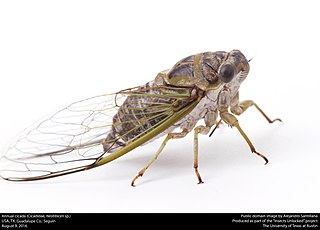
Cicadidae is the largest family of cicadas, with more than 3,200 species worldwide. The oldest known definitive fossils are from the Paleocene, a nymph from the Cretaceous Burmese amber has been attributed to the family, but could also belong to the Tettigarctidae.

Darkling beetle is the common name of the large family of beetles Tenebrionidae. The number of species in the Tenebrionidae is estimated at more than 20,000 and the family is cosmopolitan in distribution.
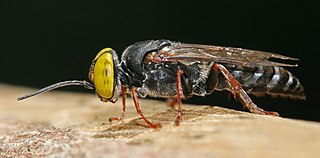
The Crabronidae are a large paraphyletic group of wasps, including nearly all of the species formerly comprising the now-defunct superfamily Sphecoidea. It collectively includes well over 200 genera, containing well over 9000 species. Crabronids were originally a part of Sphecidae, but the latter name is now restricted to a separate family based on what was once the subfamily Sphecinae. As this change is very recent, the subfamilies of Crabronidae likely will each eventually be treated as families in their own right, as they have been treated as such by many authorities in the past.

Colydiinae is a subfamily of beetles, commonly known as cylindrical bark beetles. They have been treated historically as a family Colydiidae, but have been moved into the Zopheridae, where they constitute the bulk of the diversity of the newly expanded family, with about 140 genera worldwide. They are diverse for example in the Australian region, from where about 35 genera are known; in Europe, though, only 20 genera are found and many of these only with few species.

The Tenthredinoidea are the dominant superfamily of sawflies within the Symphyta, containing some 8,400 species worldwide, primarily in the family Tenthredinidae. All known larvae are phytophagous, and a number are considered pests.

The Eucerini are the most diverse tribe in the family Apidae, with over 32 genera worldwide that were previously classified as members of the family Anthophoridae. All species are solitary, though many nest in large aggregations, and large "sleeping" aggregations of males are found occasionally. Most genera are distinctive in the unusually long male antennae from which the tribe derives its name. They are most diverse in the Western Hemisphere.

Delphacidae is a family of planthoppers containing about 2000 species, distributed worldwide. Delphacids are separated from other "hoppers" by the prominent spur on the tibia of the hindleg.
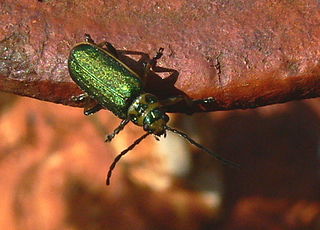
The Galerucinae are a large subfamily of the leaf beetles (Chrysomelidae), containing about 15,000 species in more than 1000 genera, of which about 500 genera and about 8000 species make up the flea beetle tribe Alticini.
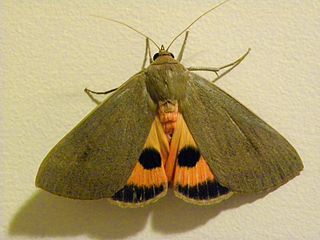
The Pyralini are a tribe of snout moths described by Pierre André Latreille in 1809. They belong to the subfamily Pyralinae, which contains the "typical" snout moths of the Old World and some other regions. The genus list presented here is provisional.

Lamiinae, commonly called flat-faced longhorns, are a subfamily of the longhorn beetle family (Cerambycidae). The subfamily includes over 750 genera, rivaled in diversity within the family only by the subfamily Cerambycinae.

Lepturinae, the lepturine beetles, is a subfamily of the longhorn beetle family (Cerambycidae), containing about 150 genera worldwide. This lineage is most diverse in the Northern Hemisphere. Until recently the subfamily Necydalinae was included within the lepturines, but this has been recently recognized as a separate subfamily. Nine tribes are usually recognized today, with a tenth, Caraphiini, created in 2016. A few genera are of uncertain placement within the subfamily.

Silvanidae, "silvan flat bark beetles", is a family of beetles in the superfamily Cucujoidea, consisting of 58 described genera and about 500 described species. The family is represented on all continents except Antarctica, and is most diverse at both the generic and species levels in the Old World tropics.
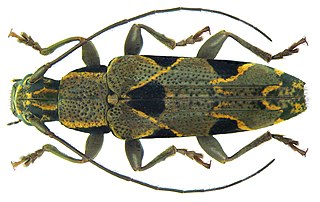
Tmesisternini is a tribe of beetles in the subfamily Lamiinae containing the following genera:

Ponerini is a tribe of Ponerinae ants with 46 genera and 6 extinct genera.
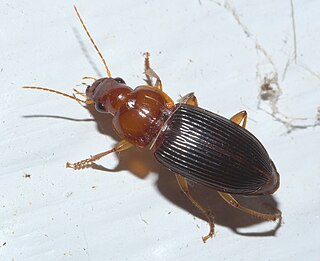
Harpalini is a tribe of a diverse group of ground beetles belonging to the subfamily Harpalinae within the broader family Carabidae. The Harpalini tribe contains an estimated 70 genera and subgenera with 357 described species.




















